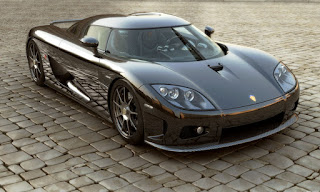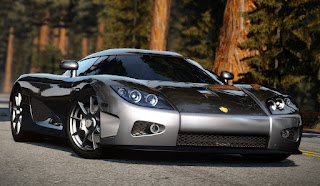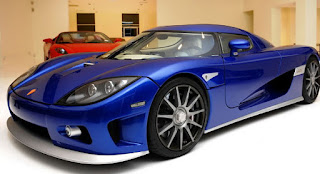Koenigsegg CCXR Cars Edition Thunderous Accelerations
This time I have filmed a full carbon Koenigsegg CCXR Edition. The CCXR Edition was only produced in four examples and featured a number of unique specifications, including a 4.8 litre twin-supercharged V8 flexfuel Koenigsegg engine producing a massive 1018HP and sprints the car from 0 to 60 mph in 2.9 seconds and up
The Koenigsegg CCX is a mid-engined sports car built by Koenigsegg Automotive AB. The project began with the aim of making a global car, designed and engineered to comply with global safety and environment regulations, particularly to enter the United States car market. To sell cars in the US many alterations were made to the design of the CCR; the previously used Ford Modular engine was replaced by a Koenigsegg engine designed to run on 91 octane fuel, readily available in the United States, and to meet the Californian emission standards.
The CCX was unveiled at the 2006 Geneva Motor Show, sporting body modifications to meet US regulations and a new 4.7 L twin supercharged V8 engine capable of producing 806 PS (593 kW; 795 hp) at 7000 rpm and 920 N·m (679 lb·ft) at 5700 rpm of torque while running on 91 octane gasoline.
CCXR was truly a wonder car. It took care of performance as well as in-cabin comfort to make the car livable. For safety CCXR had dual air bags, and bucket seat with safety harness. Seats, pedals and steering wheels were completely adjustable according to the users’ preference. Among other gadgetry, the car had a satellite navigation system, music system with USB connection, climate control, G-sensor, tire-pressure monitoring and digital temperature warning system.
CCXR looked quite similar to CCX. Like any top grade street legal supercar, it’s a two-seater coupe. Hardtop of the car was removable and could be stored in the front boot. Sturdy body frame was constructed with carbon fiber and Kevlar composite along with lightweight sandwiched reinforcements. Dimension-wise, CCXR was 4293 mm long and 1996 mm wide. Low drag area, flat underbody, venture tunnel and rear spoiler are some of the basic exterior features. They helped the car to attain low drag coefficient of only 0.33 and also made the car lot stable even at top of the scale speed.
The new engine is of all aluminum construction, made out of 356 aluminum with a T7 heat treat to further enhance block integrity and cylinder bore chill during casting. Specifically created and cast for Koenigsegg by Grainger & Worrall, a casting specialist with F1 experience in drivetrain components, the engine is built, assembled and tested at their Ängelholm production plant. The engine is lubricated with a dry sump system with a separate oil pump and the pistons are cooled by means of an internal cooler that sprays oil onto them in order to run high cylinder pressure with 91 octane fuel making it capable of 14 mpg (17 l/100 km) in combined cycle and 18 mpg (13 l/100 km) in highway travel.
The chassis is made from carbon fiber reinforced with kevlar and aluminium honeycomb like previous models and while the body keeps the targa top body style and the "dihedral synchro-helix" actuation doors it is completely reworked, there is a new front bumper design, enhanced brake cooling, fog lamps, US position lights, a new fresh air intake on the bonnet that acts as ram air booster, air intakes behind the front wheels to enhance airflow and a glass window over the engine.
The CCXR is a more "environmentally friendly" version of the CCX, powered by the same engine, but converted to use E85 and E100 ethanol fuel, as well as standard 98 octane petrol. The CCXR required modified fuel injectors, upgraded fuel lines and piston rings, and a higher boost setting on the superchargers.[10] When run on ethanol, the power increases to 1,018 PS (749 kW; 1,004 hp) at 7000 rpm and 1,060 N·m (782 lb·ft) of torque at 5600 rpm. This is a direct result of the cooling properties of ethanol in the engine's combustion chambers along with the added boost, made possible by ethanol's higher octane rating when compared to gasoline.
As the car was just being finished the FIA GT1 regulations were changed so that there had to be a minimum of 350 road cars produced per year of the model that was to compete, something that Koenigsegg was unable to achieve, prohibiting the CCGT from racing.
The Koenigsegg CCX is a mid-engined sports car built by Koenigsegg Automotive AB. The project began with the aim of making a global car, designed and engineered to comply with global safety and environment regulations, particularly to enter the United States car market. To sell cars in the US many alterations were made to the design of the CCR; the previously used Ford Modular engine was replaced by a Koenigsegg engine designed to run on 91 octane fuel, readily available in the United States, and to meet the Californian emission standards.
The CCX was unveiled at the 2006 Geneva Motor Show, sporting body modifications to meet US regulations and a new 4.7 L twin supercharged V8 engine capable of producing 806 PS (593 kW; 795 hp) at 7000 rpm and 920 N·m (679 lb·ft) at 5700 rpm of torque while running on 91 octane gasoline.
CCXR was truly a wonder car. It took care of performance as well as in-cabin comfort to make the car livable. For safety CCXR had dual air bags, and bucket seat with safety harness. Seats, pedals and steering wheels were completely adjustable according to the users’ preference. Among other gadgetry, the car had a satellite navigation system, music system with USB connection, climate control, G-sensor, tire-pressure monitoring and digital temperature warning system.
CCXR looked quite similar to CCX. Like any top grade street legal supercar, it’s a two-seater coupe. Hardtop of the car was removable and could be stored in the front boot. Sturdy body frame was constructed with carbon fiber and Kevlar composite along with lightweight sandwiched reinforcements. Dimension-wise, CCXR was 4293 mm long and 1996 mm wide. Low drag area, flat underbody, venture tunnel and rear spoiler are some of the basic exterior features. They helped the car to attain low drag coefficient of only 0.33 and also made the car lot stable even at top of the scale speed.
The new engine is of all aluminum construction, made out of 356 aluminum with a T7 heat treat to further enhance block integrity and cylinder bore chill during casting. Specifically created and cast for Koenigsegg by Grainger & Worrall, a casting specialist with F1 experience in drivetrain components, the engine is built, assembled and tested at their Ängelholm production plant. The engine is lubricated with a dry sump system with a separate oil pump and the pistons are cooled by means of an internal cooler that sprays oil onto them in order to run high cylinder pressure with 91 octane fuel making it capable of 14 mpg (17 l/100 km) in combined cycle and 18 mpg (13 l/100 km) in highway travel.
The chassis is made from carbon fiber reinforced with kevlar and aluminium honeycomb like previous models and while the body keeps the targa top body style and the "dihedral synchro-helix" actuation doors it is completely reworked, there is a new front bumper design, enhanced brake cooling, fog lamps, US position lights, a new fresh air intake on the bonnet that acts as ram air booster, air intakes behind the front wheels to enhance airflow and a glass window over the engine.
The CCXR is a more "environmentally friendly" version of the CCX, powered by the same engine, but converted to use E85 and E100 ethanol fuel, as well as standard 98 octane petrol. The CCXR required modified fuel injectors, upgraded fuel lines and piston rings, and a higher boost setting on the superchargers.[10] When run on ethanol, the power increases to 1,018 PS (749 kW; 1,004 hp) at 7000 rpm and 1,060 N·m (782 lb·ft) of torque at 5600 rpm. This is a direct result of the cooling properties of ethanol in the engine's combustion chambers along with the added boost, made possible by ethanol's higher octane rating when compared to gasoline.
As the car was just being finished the FIA GT1 regulations were changed so that there had to be a minimum of 350 road cars produced per year of the model that was to compete, something that Koenigsegg was unable to achieve, prohibiting the CCGT from racing.



No comments:
Post a Comment